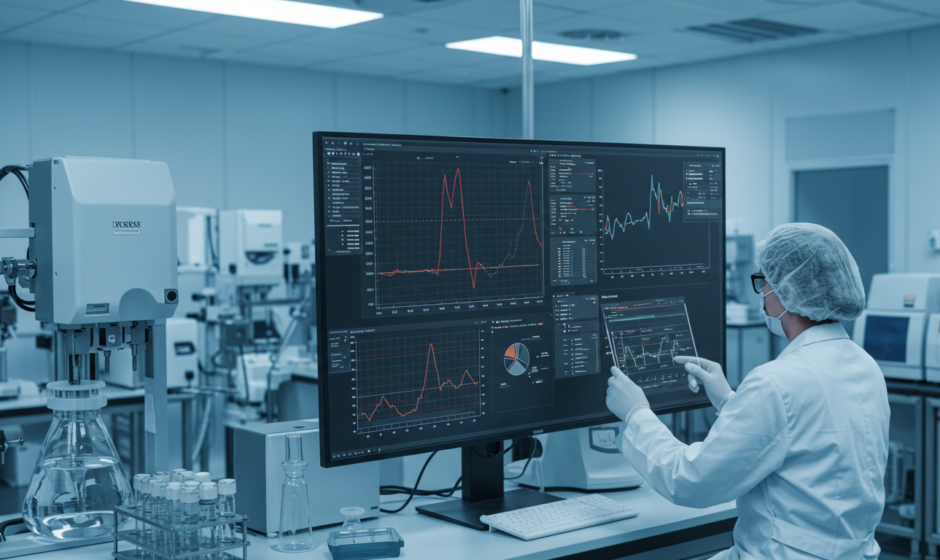Control charts play a critical role in maintaining product quality in industries like pharmaceuticals. These statistical tools help monitor processes, ensuring consistency and reducing variability in products. In the pharmaceutical industry, quality assurance is paramount, as it directly affects product safety and effectiveness. Ensuring strict adherence to quality control standards is essential for regulatory compliance and patient safety.
This blog post explores the use of control charts—specifically X-bar, R, and p-charts—in pharmaceutical quality control (QC) labs. We will delve into how these charts help track product quality and how pharmaceutical companies can benefit from them.
Understanding Control Charts
Control charts are visual tools used to determine whether a process is stable and in control. They plot data points over time, comparing them against control limits to detect trends, shifts, or outliers. The control limits are typically set at three standard deviations above and below the process mean. If data points fall outside these limits, it indicates potential issues within the process.
There are different types of control charts, but the most commonly used in pharmaceutical QC labs are X-bar charts, R charts, and p-charts. These charts allow quality control teams to track variables or attributes within a process and make informed decisions about the need for adjustments or corrective actions.
Statistical process control (SPC) is the underlying methodology behind control charts. SPC helps in identifying process variations, ensuring the production process stays consistent and meets quality standards. By using control charts, pharmaceutical companies can maintain a higher level of product quality, ultimately reducing the risk of defects or non-compliance.
X-bar and R Charts in Pharmaceutical QC
X-bar and R charts are used to monitor the variability in processes that measure continuous data, such as tablet weights or solution concentrations in pharmaceutical manufacturing. The X-bar chart tracks the average of the data points collected over time, while the R chart monitors the range of variation within subgroups of data.
These charts are particularly useful for ensuring that manufacturing processes remain stable. For example, in a QC lab, an X-bar chart may be used to monitor the average pH of a drug formulation across multiple batches. The R chart can track the range of pH values to ensure consistency within each batch.
A real-world example of the successful use of X-bar and R charts can be seen in tablet production. QC labs can use these charts to monitor the weight of tablets produced in each batch. If the X-bar chart shows a deviation from the target weight, or the R chart indicates increased variability, adjustments can be made to the tablet press settings to bring the process back in control.
p-Charts for Attribute Data
Unlike X-bar and R charts, which deal with continuous data, p-charts are used for attribute data. In pharmaceutical QC labs, p-charts are used to monitor the proportion of defective products or defects per unit over time. This type of chart is ideal for tracking binary outcomes such as pass/fail or defect/no defect.
For instance, a p-chart can be used to monitor the defect rate of blister packs in a packaging process. If the defect rate suddenly increases, it signals a problem that needs to be addressed, such as malfunctioning equipment or improper sealing.
One common example of p-chart usage in pharmaceutical QC is tracking the defect rates in injectable drug vials. The p-chart helps identify trends in the number of defective vials over time, allowing QC teams to take corrective action and prevent further defects. By identifying these trends early, pharmaceutical companies can maintain product quality and avoid costly recalls or regulatory issues.
Best Practices for Implementing Control Charts
When implementing control charts in pharmaceutical QC labs, it’s essential to select the appropriate chart based on the type of data being monitored. For continuous data, X-bar and R charts are typically used, while p-charts are best for attribute data. Choosing the right chart ensures accurate analysis of the process.
Accurate data collection is also critical. Data must be gathered consistently and precisely to ensure the reliability of the control chart. This includes determining the appropriate sampling frequency, ensuring that measurement tools are calibrated, and following proper data collection procedures.
Another crucial factor in implementing control charts is the training of personnel. Employees responsible for QC should have a strong understanding of statistical methods and control chart usage. Hands-on training in statistical quality control can empower QC staff to effectively interpret charts, detect issues early, and take corrective actions as needed.
Organizations looking to strengthen their quality control expertise may also benefit from attending relevant industry events. Participating in HR events hosted by Metmorph Edu that focus on training and development can provide valuable insights into workforce competency, which is essential for maintaining high-quality standards across departments.
Conclusion
Control charts, such as X-bar, R, and p-charts, are invaluable tools in pharmaceutical quality control labs. They provide a systematic approach to monitoring and improving product quality, helping companies maintain consistency in their manufacturing processes. By adopting these charts, pharmaceutical companies can improve quality assurance and meet regulatory requirements more effectively.
The future of quality control in the pharmaceutical industry will likely see increased reliance on data-driven tools like control charts. As QC labs continue to adopt statistical methods, the industry will benefit from improved product quality, fewer defects, and greater customer satisfaction.
To stay ahead in quality assurance practices, pharmaceutical professionals can also explore advanced training and industry insights offered by Metamorph Edu, a leader in professional development and regulatory education.
For more blogs read at: https://fastpanda.in/
FAQs
What are the key differences between X-bar, R, and p-charts?
X-bar and R charts are used for continuous data, where X-bar tracks the average and R tracks the range of variability. P-charts are used for attribute data, such as tracking the proportion of defective items or defects.
How often should control charts be updated?
Control charts should be updated whenever new data is collected. Regular updates ensure that the chart reflects the most current state of the process and can help detect trends or shifts early.
What are common challenges faced when implementing control charts in QC labs?
Common challenges include selecting the appropriate control chart, ensuring accurate data collection, and training personnel to interpret the charts correctly. Addressing these challenges is crucial to successfully implementing control charts in pharmaceutical QC labs.
Can control charts be used for all types of pharmaceutical products?
Yes, control charts can be used for a wide range of pharmaceutical products, including tablets, injectables, and packaging. The type of control chart used will depend on the nature of the data being monitored, such as continuous or attribute data.
What resources are available for further learning about control charts?
Hands-on training courses in statistical quality control are highly recommended for individuals looking to deepen their understanding of control charts.



